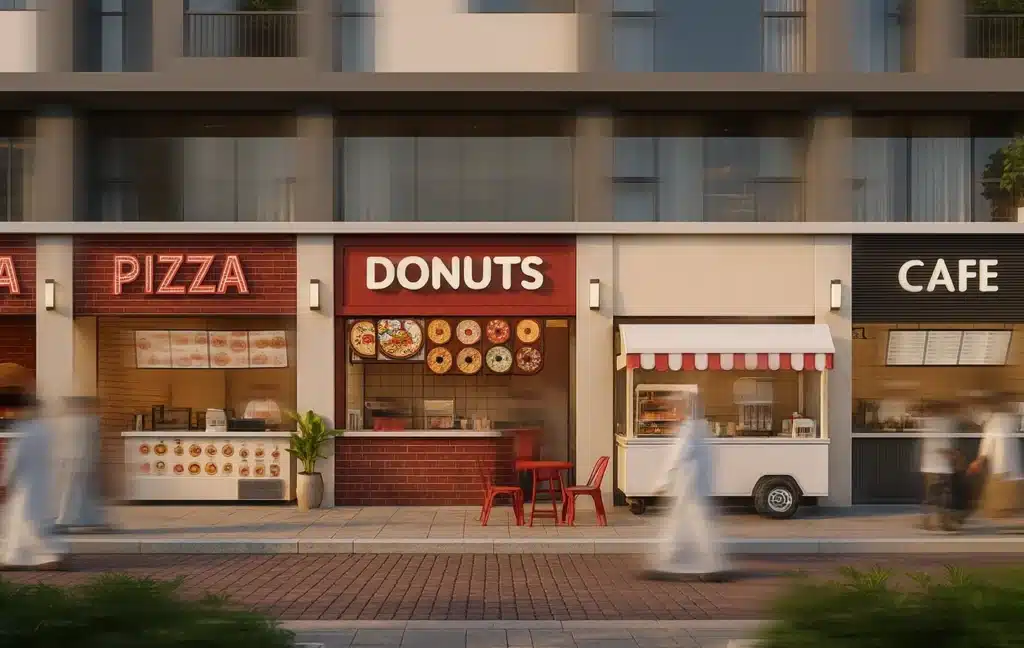The restaurant and coffee shop sector has experienced significant growth in recent years, resulting in a diverse array of restaurant models and types that cater to a wide range of tastes and needs.
The industry has evolved beyond traditional dining establishments to include innovative concepts such as fast-food or quick service restaurants (QSRs), cafés, food trucks, fine dining concepts, and cloud kitchens.
This diversity in models has created distinct operational requirements for each restaurant type, making it impractical to rely on a single technical solution.
As competition heats up, restaurants need to consider investing in technology that’s tailored to their specific restaurant type. Doing so can be key to their long-term success as it helps improve operations, reduce waste, and create unique customer experiences.
Discover the different restaurant types and the tech each type uses to enhance daily operations, admin tasks, and overall efficiency.
Fast-food and QSRs
Fast-food joints and QSRs prioritize speed, efficiency, and the ability to manage high volumes of orders to meet customer demand. They often encounter challenges such as peak hours, short preparation times, and the need for accurate orders.
Recommended technologies for these establishments include:
- Point-of-sale (POS) system: Selecting the right POS system is crucial for quick and efficient order processing, improving the cashier system experience, and minimizing errors. A good POS system also integrates with the restaurant’s accounting system.
- KDS: The kitchen display system (KDS) streamlines kitchen workflow. It displays orders as soon as they are made to kitchen staff, ensuring clarity. This reduces order delays and enhances preparation efficiency.
- Customer screens: A customer display screen (CDS) allows patrons to view their order details, confirm their selections, and make payments directly through the screen. This feature enhances transparency, builds trust, and speeds up the purchasing process.
- Self-service kiosks: An interactive touchscreen kiosk enables customers to browse the menu, select meals, customize their orders, and pay without having to wait in line. Self-service kiosks improve service, lighten the workload for cashiers, and promote new items while reducing costs associated with printing menus.
- Website or mobile app development: Consider creating a website or mobile app for your restaurant using platforms like Foodics Online, which also allows integration with delivery apps through the Foodics marketplace. This approach can expand your customer base and boost revenue.
Traditional restaurants
Traditional restaurants are family-oriented or casual establishments that offer balanced service and get a medium volume of orders. They are not classified as fast-casual or fine dining. These concepts often encounter challenges in managing wait times and coordinating work between the kitchen and the dining room.
Recommended technologies:
- Cashier app integrated with table management and reservations: This solution helps front-of-house (FOH) staff manage table allocations, and accurately record reservations. It facilitates guest flow and reduces unnecessary wait times.
- KDS: This system unifies communication between the kitchen and dining room by sending orders directly to the kitchen as soon as they are logged.
- CRM: The restaurant customer relationship management (CRM) system allows restaurants to build a customer database that includes customer preferences and visit history. This can help you create personalized offers and services to foster long-term relationships that increase repeat visits.
- Menu engineering: This analytical solution helps restaurant owners understand the performance of each menu item concerning sales and profit margins. It enables data-driven decisions to enhance the menu and increase profits.
- Pay-at-the-table: This Foodics feature allows customers to pay their bill directly at the table by scanning a QR code with their phone, eliminating the need for a cashier or wait for a server. This enhances the payment experience, reduces the pressure on staff during peak hours, and improves overall customer satisfaction and service flow.
Fine dining restaurants
Fine dining concepts provide exceptional service, with a special attention to detail, premium food quality, and a sophisticated atmosphere. This model demands a high level of personalization and precision throughout the customer experience, from reception to checkout.
The challenge lies in offering personalized service to discerning customers while managing ingredients meticulously, controlling food costs and without compromising quality.
Recommended technologies:
- Waiter tablets: These devices allow servers to take orders quickly and deliver them to the kitchen. Customers can customize their dishes by adding notes, and the tablets facilitate direct payment from the table, creating a seamless and luxurious experience.
- Inventory management: An inventory management system helps track the use of premium and expensive ingredients. It ensures availability, controls portions, and helps avoid waste while improving supply and cost efficiency.
- Restaurant CRM: Used to create profiles for VIP customers, CRMs can include dietary preferences, preferred tables, and special occasions. It helps deliver a tailored experience, enhancing customer loyalty and repeat business, and contributing to a luxurious dining atmosphere.
- Foodics Business Intelligence (BI): This advanced, AI-powered system assists restaurant owners in making strategic decisions based on accurate, real-time data. It offers analytical tools such as sales forecasting, inventory tracking, interactive reports, and comparisons. Additionally, it integrates seamlessly with the Foodics ecosystem, providing a comprehensive view of performance and helping to reduce waste.
Cafés, bakeries, and pastry shops
Coffee shops and bakeries need efficient checkout processes and speedy order fulfillment. Staff need to have upselling skills to boost average customer spend or average order value (AOV).
With busy mornings, limited staff, and seasonal changes in product offerings, cafes and bakeries need tech like smart inventory management software to maintain efficiency and profitability.
Recommended technologies:
- Foodics Pay: A secure payment solution that allows for easy acceptance of all types of payment methods.
- Inventory management: A system that tracks ingredient quantities accurately and in real-time. It sends automatic alerts when stock is low, facilitating reordering and helping to reduce waste from perishable items, enhancing operational efficiency.
- Loyalty programs: Coffee shop loyalty programs can strengthen customer engagement and encourage repeat visits. These loyalty programs use a points system that rewards customers for every purchase. They can redeem points for free drinks or discounts. Customers can also receive exclusive offers and personalized alerts via SMS or push notifications, increasing their sense of appreciation and encouraging them to visit more frequently.
Cloud Kitchens
Cloud kitchens are commercial facilities specifically designed to prepare food exclusively for delivery. They do not have a reception or dining area and can be used by one or more brands.
This model features lower operating and rental costs, enabling more competitive pricing for customers. Since there is no traditional customer area, you’ll need to use digital channels carefully to provide an integrated experience across apps and websites. This requires flexible and efficient systems.
Recommended technologies:
- Foodics’ POS system integrated with delivery apps: This unified platform consolidates all orders from apps like Talabat, HungerStation, and Jahez onto a single screen. It eliminates the need for multiple screens, reduces the impact of changing work environments, and mitigates issues with unstable internet connections.
- Inventory management: Foodics’ inventory feature allows for precise tracking of raw materials, from sourcing to consumption. It includes smart alerts for shortages and provides detailed reports on costs and waste, helping maximize resource usage and improve profit margins and operational efficiency in cloud kitchens.
- Foodics Online: This Foodics platform lets you create a website or mobile app for your brand, even with zero programming experience. It offers fully customizable designs that align with your restaurant’s visual identity and automatically links to food menus. It also supports order management and payment, online orders, among others, ensuring a seamless experience from browsing to receiving their order.
- Intelligent reporting to improve performance: Analytics and POS system reports offer accurate insights into the performance of each brand and delivery channel, including specific data such as Talabat or Jahez. This information can help you identify your most profitable brands and peak times, allowing for effective resource allocation and strategic business decisions.
Further reading: How to Grow Your Restaurant with a Cloud Kitchen
Food Trucks
Food trucks and pop-up restaurants provide flexibility and the ability to reach customers in various locations. However, they face challenges due to limited space.
Recommended technologies:
- Foodics One: Foodics one is an integrated POS system that connects to the Foodics platform. It includes a cashier, a payment gateway, and a fast printer, all designed to be compact enough for spaces with limited room, such as food trucks.
Further reading: Top Menu Pricing Factors that Guarantee High Profits
Conclusion
Selecting the right technology for your restaurant type is crucial for achieving success and sustainability in the F&B industry. Each operating model, whether it’s fine dining or food trucks, requires intelligent tools that cater to each type’s unique needs and address specific challenges effectively.
At Foodics, we believe that every business, regardless of size, from large establishments with multiple branches to emerging ventures, deserves access to tools that facilitate growth and excellence in a rapidly changing market. We are committed to providing the most suitable solutions tailored to your business concept.
Foodics is your ideal technology partner, offering integrated solutions for all sizes and types of restaurants. Our offerings include a POS system, inventory and employee management, business reporting, self-service kiosks, integration with delivery platforms, and more. These solutions help restaurants manage their operations efficiently and achieve their goals.
Discover Foodics’ restaurant solutions designed for you today!



